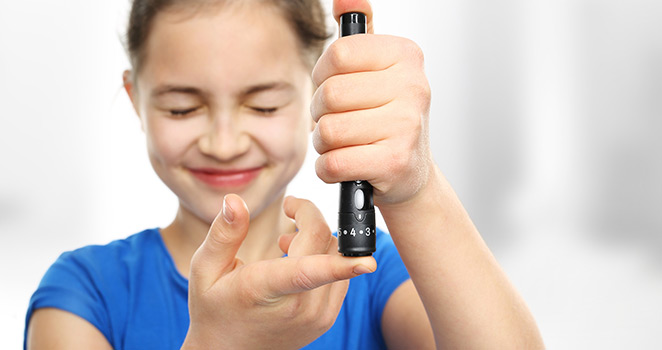Pediatric Type 1 & Type 2 Diabetes Mellitus

An ever-increasing number of children are developing diabetes. Very young children who develop the disease are most likely to be diagnosed with type 1 diabetes mellitus, a lifelong illness characterized by the body's inability to produce insulin, resulting in high blood sugar levels. Type2 diabetes is often seen in older children and adults whose bodies do not produce insulin, do not produce enough insulin, or do not use insulin effectively.
Symptoms
Those that develop either type 1 or type 2 diabetes may experience a variety of symptoms. Children may experience unexplained weight loss while continuing with a normal diet and appetite. Additionally, patients with high blood sugars may exhibit extreme thirst and excess urination. Finally, a general feeling of malaise and tiredness may be problematic, often leading to irritability and a change in sleeping patterns.
Causes
Type1 Diabetes Mellitus is caused by the body's inability to produce insulin. The pancreas normally produces insulin when a person eats, and it keeps blood sugar within normal limits. Those with type 1 diabetes do not produce any insulin. This is caused by the autoimmune destruction of beta cells in the pancreas.
Type 2 diabetes is responsible for 95 percent of all diabetes cases, according to the CDC. A number of different factors such as heredity or lifestyle choices can cause it. A significant number of those with type2 diabetes mellitus are overweight and do not participate in any exercise, which can be a part of the disease's cause. Age, ethnicity, and diet also play a part in the development of type2 diabetes.
How is Type1 or Type2 Diabetes Mellitus Diagnosed?
The definitive diagnosis of either type of diabetes is done through blood testing. The amount of sugar in the blood can be determined in several ways. First, a fasting blood sugar level can be determined. Fasting blood sugar levels under 100 mg/dL are considered normal, between 100 mg/dL and 126 mg/dL are considered borderline, and over 126 mg/dL are considered diabetic.
Other tests may include a glucose tolerance test or the A1c test. The glucose tolerance test measures the way the body responds after a sugar solution is introduced. A patient's blood is tested at various intervals after drinking the sugar solution to determine if values are normal. The A1c test measures the sugar in the red blood cells over a three-month time span. It is not a method for diagnosis, but it is helpful for monitoring and controlling the disease.
Treatment
When a child is diagnosed with type 1 diabetes, he will almost certainly need to depend on insulin throughout life. There are many different types of insulin available including long-acting, medium acting, and rapid acting. A combination of these different types of insulin may be required for complete blood sugar control. It is often a matter of experimentation to determine which insulin will work best with each patient.
In addition to the types of insulin, a patient requires, the timing of when a patient takes insulin is also important. For example, rapid-acting insulin needs to be taken just before eating a meal while long-acting insulin needs to be taken at about the same time every day.
How Do Diet and Exercise Effect Type1 and Type2 Diabetes Mellitus?
The food choices one make will affect the blood sugar control of a person with either type 1 or type 2 diabetes. Eating foods very high in sugar or simple carbohydrates will raise blood sugar significantly. A person needs to eat a balanced diet that includes some carbohydrates along with protein and fat. Proteins and fats eaten along with carbohydrates will slow the absorption for a less significant blood sugar rise. A nutritionist may be able to help create a food plan that will be beneficial.
Exercise is an important component of diabetes treatment. While helping to keep the cardiovascular system healthy, exercise can also lower blood sugar. For children, exercise can simply be outdoor games, dancing, or sports.
The Difference Between Type1 and Type2 Diabetes Mellitus
There are several differences between type1 and type2 diabetes mellitus. First, type 1 diabetes most often develops in young children while type2 diabetes can occur at any age. Additionally, type1 patients are dependent on insulin because their pancreas does not produce any. Those with type2 may produce some insulin in their pancreas, but they do not produce enough, or it is not used efficiently in their bodies.
Another difference between the two types is that those with type one can experience episodes of low blood sugar as well as high levels while those with type2 rarely do. Moreover, type1 diabetes cannot be prevented, but, in many cases, type2 can be avoided. Finally, there are many more cases of type2 diabetes are documented.
How Are Type1 and Type2 Diabetes Mellitus Similar?
Both types are similar in that they can cause complications if not treated properly. Blindness, kidney failure, and amputations are just some of the possible complications of diabetes when it is left untreated. In addition, both types are monitored in a similar manner and both can be treated with insulin when necessary. Care must be taken with all diabetic patients to keep blood sugar levels consistent.